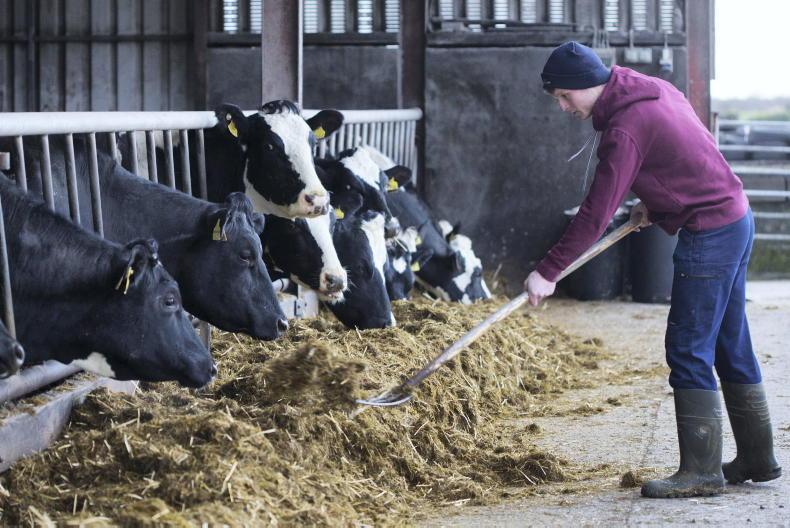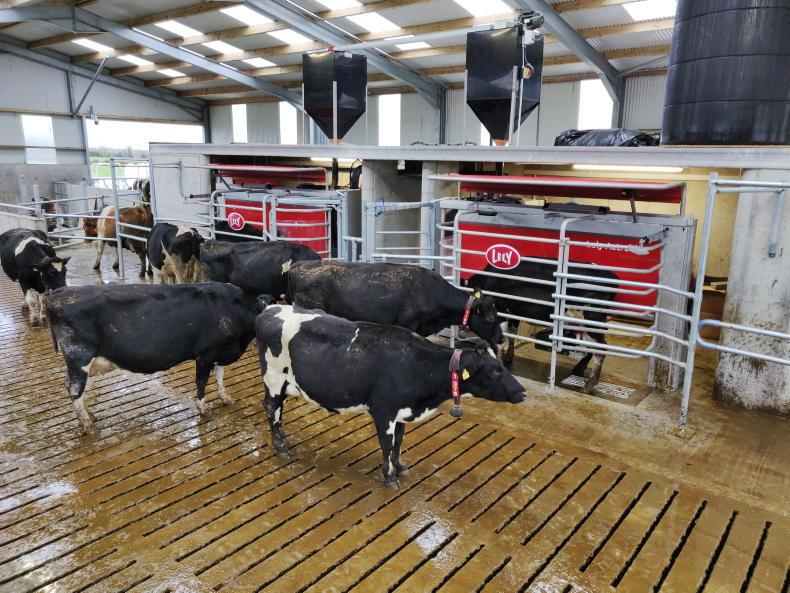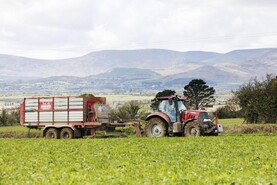There has been an increase in the number of dairy farms adopting some form of automation to reduce the peak in labour demands associated with a spring-calving, grass-based system.
The Irish Farmers Journal recently caught up with Lely’s William Conlon to discuss the main drivers towards automation on Irish dairy farms. William explains that automation investments typically include a wide range of items such as robotic milking systems, automatic calf feeders, robotic scrapers, automatic heat detection and drafting systems, automatic feed pushers, automatic teat sprayers and even automatic footbaths.
In other industries, the focus is on automating processes that are repeatable or mundane. On a dairy farm, these can include calf feeding, heat detection and milking.
These are all labour-intensive jobs that are central to the success of the business and occur predominantly over a four-to-five-month window, William explains.

Automating processes that are repeatable or mundane is common in many businesses.
Eliminating one of these from the daily workload can greatly reduce the labour demands placed on a farm during the busy spring period. At farm level, there can be a reluctance to go down the automated route and confidence in the system needs to be gained before making the decision to invest.
A large part of his current role is focused on robotic milking systems and a common occurrence over the past few years is a farmer adopting automation at a smaller level, such as a robotic yard scraper or heat detection system, for example. After a few years, this has given them confidence that the technology can work and may push them to make a bigger investment in a robotic milking system.
The grant aid available through the Targeted Agricultural Modernisation Scheme (TAMS) has been a big help for existing dairy farmers in modernising their farms. In 2020, 29% of payments made to farmers for milking equipment through TAMS was for robotic milking systems, he says.

TAMS has been a big help for existing dairy farmers in modernising their farms.
Confidence in automation can also come from seeing a neighbour or a farmer in the same discussion group using a system successfully and often leads to a proliferation of systems in an area once one is installed.
New entrants v existing farmers
William says that in his experience, the number one driver towards automation on dairy farms is in relation to sourcing and retaining good labour, particularly on larger farms of over 200 cows.
In many cases, farmers are looking for an all-rounder, someone who is a good stockperson, who can spot a sick animal, while also being capable of working machinery.
It is not always an easy mix to achieve and sensor technology such as collars that monitor a cow’s activity, heat detection and rumination can provide a lot of information to pick up a sick cow that may not have been visually spotted.
It can be particularly useful where there is hired labour who may not have as much experience as the farm owner, or in larger herds where there may be less knowledge of individual cows. Such systems are often combined with an automatic drafting gate and can be a big time-saver around milking.
In terms of new entrants, the focus is more so on the information that can be retrieved from sensor technology or robotic milking systems, which can greatly ease the move into a new farming system away from sucklers or beef, he says.
Sensors that provide early identification of mastitis and daily information on somatic cell count are common on robotic milking systems and provide invaluable information for any farm, particularly with new regulations eliminating blanket dry-cow treatment.
Bad experiences
Just as a good experience can encourage neighbouring farms to increase automation, a bad experience can have a long-lasting negative effect in an area, William remarks.
Some counties have been quicker to adopt technologies such as robotic milking systems than others due to a legacy of poor support and service, and this has been difficult to shake off in certain areas. The same is true for all types of automation at farm level.
Where you have a big reliance on automation on your farm, you also have a big reliance on the service and support teams to ensure that the system is set up correctly and that the machines stay running efficiently.
Whether it is a calf feeder or robotic milking system, if it is down for any extended period of time, it will cause issues.
Younger generations
He explains that the challenge of encouraging younger generations into farming is ever present and one that he comes across on farms regularly. The farm has to be an attractive place to work if the next generation is going to take it on.
Work-life balance has become a bigger focus for young farmers, whether they are milking through a parlour or a robotic milking system.
There is a desire for greater flexibility and automation is being used to achieve this.
Increasingly, older farmers are investing in automation to make the farm a more attractive prospect for the next generation to come back to, where they may have spent a period of time working away from the farm.
In any growing industry, automation is used to reduce the burden on labour, and farming is no different.
There has been sharp rise over the past three years in sensor technology and robotic milking systems in particular, as farmers try to balance the hours worked on their farms, both by themselves and hired labour, while continuing to improve performance.
William concluded by saying he believes that moving into the future, the importance of automation on farms will only continue to grow.
There has been an increase in the number of dairy farms adopting some form of automation to reduce the peak in labour demands associated with a spring-calving, grass-based system.
The Irish Farmers Journal recently caught up with Lely’s William Conlon to discuss the main drivers towards automation on Irish dairy farms. William explains that automation investments typically include a wide range of items such as robotic milking systems, automatic calf feeders, robotic scrapers, automatic heat detection and drafting systems, automatic feed pushers, automatic teat sprayers and even automatic footbaths.
In other industries, the focus is on automating processes that are repeatable or mundane. On a dairy farm, these can include calf feeding, heat detection and milking.
These are all labour-intensive jobs that are central to the success of the business and occur predominantly over a four-to-five-month window, William explains.

Automating processes that are repeatable or mundane is common in many businesses.
Eliminating one of these from the daily workload can greatly reduce the labour demands placed on a farm during the busy spring period. At farm level, there can be a reluctance to go down the automated route and confidence in the system needs to be gained before making the decision to invest.
A large part of his current role is focused on robotic milking systems and a common occurrence over the past few years is a farmer adopting automation at a smaller level, such as a robotic yard scraper or heat detection system, for example. After a few years, this has given them confidence that the technology can work and may push them to make a bigger investment in a robotic milking system.
The grant aid available through the Targeted Agricultural Modernisation Scheme (TAMS) has been a big help for existing dairy farmers in modernising their farms. In 2020, 29% of payments made to farmers for milking equipment through TAMS was for robotic milking systems, he says.

TAMS has been a big help for existing dairy farmers in modernising their farms.
Confidence in automation can also come from seeing a neighbour or a farmer in the same discussion group using a system successfully and often leads to a proliferation of systems in an area once one is installed.
New entrants v existing farmers
William says that in his experience, the number one driver towards automation on dairy farms is in relation to sourcing and retaining good labour, particularly on larger farms of over 200 cows.
In many cases, farmers are looking for an all-rounder, someone who is a good stockperson, who can spot a sick animal, while also being capable of working machinery.
It is not always an easy mix to achieve and sensor technology such as collars that monitor a cow’s activity, heat detection and rumination can provide a lot of information to pick up a sick cow that may not have been visually spotted.
It can be particularly useful where there is hired labour who may not have as much experience as the farm owner, or in larger herds where there may be less knowledge of individual cows. Such systems are often combined with an automatic drafting gate and can be a big time-saver around milking.
In terms of new entrants, the focus is more so on the information that can be retrieved from sensor technology or robotic milking systems, which can greatly ease the move into a new farming system away from sucklers or beef, he says.
Sensors that provide early identification of mastitis and daily information on somatic cell count are common on robotic milking systems and provide invaluable information for any farm, particularly with new regulations eliminating blanket dry-cow treatment.
Bad experiences
Just as a good experience can encourage neighbouring farms to increase automation, a bad experience can have a long-lasting negative effect in an area, William remarks.
Some counties have been quicker to adopt technologies such as robotic milking systems than others due to a legacy of poor support and service, and this has been difficult to shake off in certain areas. The same is true for all types of automation at farm level.
Where you have a big reliance on automation on your farm, you also have a big reliance on the service and support teams to ensure that the system is set up correctly and that the machines stay running efficiently.
Whether it is a calf feeder or robotic milking system, if it is down for any extended period of time, it will cause issues.
Younger generations
He explains that the challenge of encouraging younger generations into farming is ever present and one that he comes across on farms regularly. The farm has to be an attractive place to work if the next generation is going to take it on.
Work-life balance has become a bigger focus for young farmers, whether they are milking through a parlour or a robotic milking system.
There is a desire for greater flexibility and automation is being used to achieve this.
Increasingly, older farmers are investing in automation to make the farm a more attractive prospect for the next generation to come back to, where they may have spent a period of time working away from the farm.
In any growing industry, automation is used to reduce the burden on labour, and farming is no different.
There has been sharp rise over the past three years in sensor technology and robotic milking systems in particular, as farmers try to balance the hours worked on their farms, both by themselves and hired labour, while continuing to improve performance.
William concluded by saying he believes that moving into the future, the importance of automation on farms will only continue to grow.








 This is a subscriber-only article
This is a subscriber-only article










SHARING OPTIONS: